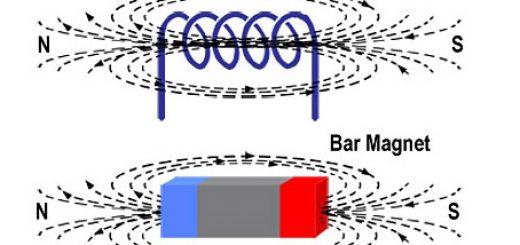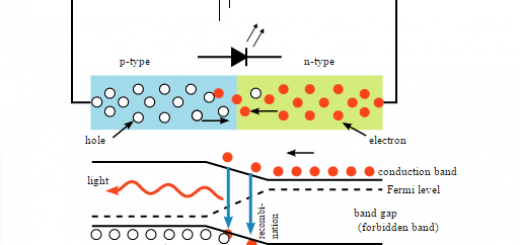Sound intensity, Factors affecting Sound intensity and Applications of ultrasonic waves
The intensity of sound decreases four times as the distance between the ear and sound source is doubled because the intensity of sound is inversely proportional to the square of the distance between the ear and the sound source. The piano sound differs from that of the violin even if they have the same intensity and pitch due to the difference in harmonic tones that associate the fundamental tone of each of them.
Sound intensity (I)
Sound intensity is the property by which the ears can distinguish (differentiate) strong or weak sounds. The measuring unit of sound intensity is watt/m². Examples: Whispering is described as a weak sound, and shouting is described as a strong sound. So that, whispering has less intensity than shouting.
The intensity of sound at a certain point is measured by the quantity of sound energy falling perpendicularly in one second on a unit area at that point: (If the sound energy is high, it gives a strong sound, but if it is low, it gives a weak sound).
Due to the wide range of sound intensity heard by humans and the variance in sensitivity to sound intensity from one person to another, scientists agreed to express the level of sound intensity or noise intensity by using the Decibel scale. The measuring unit of the level of sound intensity (noise intensity) is “Decibel”.
Factors affecting the sound intensity
- Distance between the ear & the sound source.
- The amplitude of vibration of the sound source.
- The area of the vibrating surface
- The medium density through which sound travels (propagates)
- The wind direction.
1. The distance between the ear and the sound source
If you stand in front of your classmate, who produces a sound, then you move away from him gradually. You notice that the intensity of sound becomes fainter gradually as you move farther away from the sound source. This is because the intensity of sound (I) at a point is inversely proportional to the square of the distance (d²) between that point and the sound source and this is known as “The inverse square law of sound”
The inverse square law of sound: The intensity of sound at a point is inversely proportional to the square of the distance between that point and the sound source. The sound intensity ∝ 1/square of the distance. I ∝ 1/d².
When the distance between the sound source and the ear increases twice, the intensity of sound decreases to a quarter. The distance between the sound source and ear decreases to half, The intensity of the sound increases to four times its value.
The intensity of sound increases four times when the distance between the sound source and the ear decreases to its half value or it is preferred to sit in the first rows more than the back rows in lecture classes. because the sound is inversely proportional to the square of the distance between the ear and the sound source.
2. The amplitude of vibration of the sound source
Fix one end of a ruler on the edge of a table with your right hand. Pull the other end of the ruler downwards, then leave it free. Notice the sound produced by the vibration of the ruler. The intensity of sound decreases as time passes. The amplitude of the ruler decreases gradually as time passes.
Sound intensity decreases gradually by decreasing the amplitude of the vibration because the sound intensity is directly proportional to the square of the amplitude of the vibration of the sound source. Sound intensity ∝ Square of the amplitude. When the amplitude increases 2 times, the intensity of sound increases 4 times.
3. The area of the vibrating surface
Hold your mobile, which is adjusted to the vibrating mode in your hand, then ring on it from another mobile. Put the phone on an empty box, which is opened at one of its sides to work as a resonance box. Compare between the intensity of sound that is produced in each case. The sound produced from the phone which is placed on the resonance box is stronger than that produced from the phone which is held.
The resonance box increases the vibrating surface area. Sound intensity increases by increasing the vibrating surface area when the source of sound touches a resonance body (box).
We notice in the stringed musical instruments such as the guitar and the violin that the strings are fixed above an empty wooden box (resonance box) to increase the sound intensity. Sound intensity increases when the sound source touches a resonance box, due to the increases in the vibrating surface area.
4. The medium density
Ring the alarm clock, then put it on the air vacuum pump and cover it with the glass jar. The sound is heard clearly. Evacuate (pump-out) the air inside the jar gradually (by pulling the arm of the vacuum pump outwards). The sound intensity decreases gradually until it stops as the air is pumped out of the jar.
The air density decreases as you pull the air vacuum pump outwards, so the sound intensity decreases. Sound intensity decreases by decreasing the density of the medium and vice versa. Sound intensity is directly proportional to the density of the medium in which sound travels.
The sound intensity in the case of the presence of carbon dioxide gas as a medium is higher than that in the case of air, Because the density of carbon dioxide gas is more than that of air since the intensity of sound is directly proportional to the density of the medium. The sound intensity of a fired shot on the top of a mountain is less than that at its foot (bottom) because the density of air at high regions is less than at the ground.
5. The wind direction
The intensity of sound increases when the direction of sound waves propagation is in the same direction as the wind, The intensity of sound decreases when the direction of sound waves propagation is in the opposite direction of the wind.
Sound quality (Type)
Sound quality (Type) is the property by which the human ear can distinguish (differentiate) between different sounds according to the nature of the source even if they are equal in intensity and pitch.
How can human ears distinguish between sounds from different sources [such as tuning fork, violin and piano]:
The tone produced from a vibrating tuning fork is a pure simple tone known as the fundamental (basic) tone. The tone produced from a violin or a piano even if they are equal in pitch and intensity they are complex tones.
These complex tones are composed of a fundamental tone associated with other tones higher in pitch and lower in intensity known as “harmonic tones”. These harmonica tones differ from one source of sound to another depending on the nature of the sound source.
Harmonic tones are tones that accompany the fundamental (basic) tone but they are higher in pitch and lower in intensity and differ from one instrument to another. The human ears distinguish between sounds from different sources even if they are equal in intensity and pitch, due to the difference in the harmonic tones that associate the fundamental tone produced from the source of the sound.
Comparison between sound waves according to their frequencies
The human ears are affected by sounds of a frequency ranges between 20 Hz – 20 KHz, Based on the frequencies of sounds that the human ear recognizes, sound waves are classified as in the following order:
Sounds waves
- Infrasonic waves are sound waves of frequencies lower than 20 Hz. Such as the waves accompany the blowing of storms that precede rainfall and the human ear cannot hear them.
- Sonic waves are sound waves of frequencies ranging from 20 Hz to 20 KHz (20000 Hz). Such as the waves that the human ear can distinguish between them and can hear them.
- Ultrasonic waves are sound waves of frequencies higher than 20 KHz (20000 Hz). Such as some animals such as bats, dogs and dolphins can hear ultrasonic waves and the human ear cannot hear them.
Some sound waves can’t be heard, because the frequencies of these waves are lower than 20 Hz or higher than 20 KHz, so the human ears cannot hear them.
Range of the heard sounds by some living organisms
Dogs can hear all sounds produced by man because the range of sounds produced by man lies within the range of sounds heard by dogs. Man can’t hear sounds produced by a dolphin or a bat because a dolphin or a bat produces ultrasonic waves, while the human ears can’t hear sounds of frequencies more than 20 kilohertz.
When the Ethiopian chickens that live in Africa depart their home suddenly, this gives an indication of rainfall the day after, This is explained by their high sensitivity to the infrasonic waves associated with weather changes preceding rainfall, On the other hand, some sea creatures like shrimp and whales produce ultrasonic waves as sound shots to kill the fish they feed on.
Applications of ultrasonic waves
Ultrasonic waves are used in several medical, industrial, and military fields such as
- Medical: Breaking down kidney and ureter stones without any surgical interventions (operations), Diagnosis of male prostate gland tumors and their effect on the bladder, and discovering malignant tumors.
- Industrial: Sterilization of food, water, and milk as ultrasonic waves are characterized by their high ability to kill some types of bacteria and stop the action of some viruses
- Military: The discovery of landmines.
When ultrasonic waves collide with a landmine, it vibrates, And due to this vibration, it produces waves that travel through the Earth’s surface to be discovered by using a specialized laser device.
Audible sounds, Doppler’s effect, Savart’s wheel importance, Sound properties and velocity
The advantages and disadvantages of ultrasonic waves in detecting industrial defects
Types of motion, Relative motion, Applications of Mechanical waves and Electromagnetic waves
Role of waves in transferring energy, Wave Motion, Transverse waves and Longitudinal waves
Oscillatory Motion definition, examples, applications and properties



